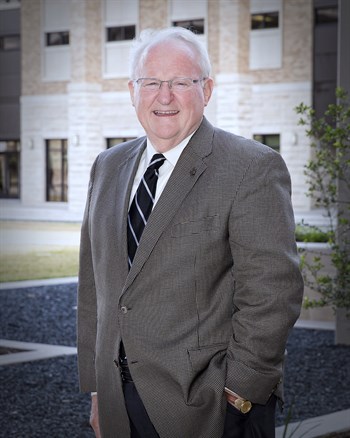Texas A&M Professor Garry Adams Receives AVMA Award
Dr. L. Garry Adams, a senior professor in the Texas A&M College of Veterinary Medicine & Biomedical Sciences’ (CVM) Department of Veterinary Pathobiology (VTPB), was honored with the American Veterinary Medical Association’s AVMA Award during the annual conference in Indianapolis.

Adams was recognized on July 22 for his contributions to organized veterinary medicine via collaboration.
“It was an indescribable honor to receive the highest award presented by the AVMA and to be supported by my peers, a pinnacle for my career, although I am far from being finished with my contributions to veterinary medicine and science,” Adams said. “As the immediate past president of the Texas Veterinary Medical Association, I am forever in the debt of Dr. Sam Miller and the Texas Veterinary Medical Association for nominating me for the American Veterinary Medical Association 2017 Award.”
This is not Adams’ first recognition by the AVMA; in 2012, he received the AVMA Lifetime Excellence in Research Award.
“Dr. Garry Adams is an extraordinary veterinary scholar who is most deserving of this prestigious AVMA Award,” said Dr. Eleanor M. Green, the Carl B. King Dean of Veterinary Medicine. “He has been passionate about the veterinary profession and has been tireless in his work over his entire, illustrious career. His impacts span the research laboratory, the classroom, and organized veterinary medicine.
“Although he is ‘retired,’ his pace has not wavered at all,” Green said. “I look forward to watching for all he will continue to contribute.”
Growing up in a small town in the mountains, in a remote part of Texas, Adams always had livestock and companion animals and worked for two local practitioners who encouraged him to attend Texas A&M to become a veterinarian.
At Texas A&M, he earned his veterinary degree in 1964 and his doctorate in veterinary anatomic pathology in 1968, and then joined the faculty.
Working with the Rockefeller Foundation and U.S. Agency for International Development, Adams went to Colombia to develop diagnostics and vaccines for anaplasmosis, babesiosis, and trypanosomiasis. Along the way, he became a diplomate of the American College of Veterinary Pathologists.
He returned to Texas A&M after five years to teach pathology and continue studying infectious diseases.
Adams’ research has focused on diseases such as brucellosis, tuberculosis, and salmonellosis. In the past decade, researchers have begun to understand the interaction on more of a molecular level.
Adams has been active in the AVMA and other veterinary organizations throughout his career. He has served as a member of the AVMA Council on Research, Council on Education, and Committee on International Veterinary Affairs; on the working group that developed the concept for the AVMA Animal Health Studies Database that launched last summer; and on the organizing committee for the AVMA Global Food Security Summit that was held earlier this year.
He is engaged in the AVMA because of his commitment to the veterinary profession.
Adams has been a member of the Texas Veterinary Medical Association’s (TVMA) Research Committee for many years. Among other activities in organized veterinary medicine, he served on the board of directors of the American Association of Veterinary Immunologists.
“One of the most accomplished veterinary professionals in the world, Dr. Adams is also one of the nicest, most unassuming individuals I have had the pleasure of meeting during my career in veterinary medicine,” wrote Dr. Sam G. Miller Jr. in nominating Adams for the AVMA Award on behalf of the Texas VMA. “He is truly one of those people who leads by example and whose quiet confidence has helped build and strengthen the reputation of every organization that has had the privilege of his service.”
Adams lives by a “team of teams” collaborative approach to complex issues, saying that he relies on his personal, faith, academic, and professional teams.
To share some of his thoughts on collaboration in research, he published “Putting together a scientific team: collaborative science” in the September 2014 issue of Trends in Microbiology.
Adams encourages his students to stay engaged in the veterinary profession through local, state, and national associations.
“Through organized veterinary medicine, I have formed lifelong networks and continue to find inspiration from interacting with my colleagues,” Adams said.


